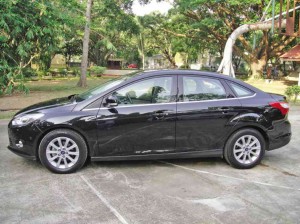In the fiercely competitive compact-car segment, some models are more enjoyable to drive than others. For now, the 2013 Ford Focus is way ahead in this aspect and here’s why.
The “why” begins to dawn on you when you see the coiled dynamism suggested by the Focus’ Kinetic Design with its aggressive front grille, bulging fenders, rising beltline and arching roofline. As you enter and take the supportive, 4-way power-adjustable driver’s seat, the low seating position and the spacious, stylishly sculpted cockpit designed to keep everything within the driver’s easy reach make you imagine that you are in control of a sports car. And when you press the power start button and hear the low rumble of the Titanium Focus’ 2.0-liter, 170 ps, gasoline direct-injected 16-valve VCT Duratec engine, your expectations of an engaging driving experience rise.
You are not disappointed. While 170 horses and 202 Newton-meters max torque are not outstandingly powerful, the exceptionally deft handling and sharp, precise steering of the Focus impress and delight you. Kudos go to Ford Motor Co. for the Focus’ astutely tuned suspension, its nicely weighted, electronic power-assisted steering and the spirited 6-speed Powershift automatic transmission that keeps the revs up when you need it—plus the Focus’ torque-vectoring front axle that improves road holding so body lean is minimal in fast turns and cornering. Moreover, the independent multilink rear suspension enhances traction as it maintains contact with the road better than a rear beam axle.
Not only is the Focus immensely fun to drive, its new direct-injection engine, 6-speed Powershift automatic tranny and improved aerodynamics reportedly boost fuel economy to 11 kilometers per liter in city driving and 16 km/liter on the highway. The fuel efficiency of the new Focus finally puts away the reputation of previous iterations as gas guzzlers.
WELL-PLANTED. With the 2013 Titanium Focus, sporty driving does not diminish riding comfort. The front section of the new Focus is roomy, with upgraded, bolstered leather sport seats in the Titanium variant that keep the driver and front passenger well-planted in swift turns. The cabin itself is attractive, quiet and as well-crafted as an upmarket European sport sedan’s. Ford succeeded in sealing engine noise out and tuning the suspension to filter out the most jarring bumps. The solid body of the Focus enhances the impression of comfort such that it feels like a bigger car than it is, especially when cruising on highways.
However, rear legroom and headroom in the 2013 Focus are just barely adequate for tallish and large passengers even as the leather upholstery and trim keep the classy look and feel in the back. The spaciousness of the front seats compared to the back suggests that Ford designed the new Focus to be a driving enthusiast’s car rather than a family carrier.
The top-of-the line Titanium Focus (P1.208 million) looks and feels more European premium-brand than other compact cars due to its solid craftsmanship, impeccable fit-and-finish, dual-zone automatic climate control, a 9-speaker Sony audio system, 4.2-inch multifunction display, smart keyless entry with power start button, cruise control and the Microsoft-powered Ford SYNC connectivity system. In front, HID headlamps with daytime-running LED strip lights and rain-sensing wipers while above, a power sunroof adds to the feeling of extra space inside.
Ford SYNC is a voice-activated system that controls features like Bluetooth, phone calls and digital music playing, but it takes a lot of practice to understand. The layout of gauges and controls in the 2013 Focus is complicated and confusing to cycle through. Complaints have been heard about unresponsive voice commands, inconsistent responses to voice commands, information overload and difficult-to-touch areas in extreme corners of the screen while driving. The radio interface has too many buttons that require counter-intuitive operation, which takes some time and patience to fully master. Ford is working to debug the connectivity system.
Leather backseat offers enough legroom and headroom even for six-footers. PHOTOS BY AIDA SEVILLA-MENDOZA
The trunk of the Focus sedan, whether Titanium or lower-spec, offers only 13.2 cubic feet of cargo space. The Focus could also do with more small-item storage space in the cabin. There are only two cupholders, door pockets, a console bin, glove box and a small cubby behind the shifter.
ACES. But the 2013 Focus aces when it comes to safety features. Ford developed the Focus as a world car, meaning its structure wasn’t merely engineered to do well on one particular safety test. The 2013 Focus earned top scores in every category from the Insurance Institute for Highway Safety and a 5-star NCAP (New Car Assessment Program) Overall Score from the National Highway Traffic Safety Administration in the United States, where it debuted in 2000. The Focus underwent a complete overhaul for 2012, changes that resonated with the American public and made it Ford’s second-best-selling car behind the Fusion up to this day.
The Titanium Focus’ list of safety equipment includes, among others, six airbags, ABS with EBD, Hill Launch Assist, electronic stability program, torque vectoring control, Active City Stop, Active Park Assist, Blind Spot Information System, speed limiter and perimeter alarm.
Two years ago, Dan Neil, a motoring columnist of The Wall Street Journal, wrote that the best compact cars on the market are the Ford Focus and the Hyundai Elantra. Ford and Hyundai, he said, “have broken away from the mass-market peloton and they’re in a race all their own. One’s an incumbent, one’s an insurgent …And with the Focus and the Elantra, it’s wheel-to-wheel, right to the tape.”
So which car got his vote as the best of the best? Which “estimable machine” would he advise shoppers to choose? Noting that the Focus loves to run and feels appreciably more spirited and willing with its 6-speed dual-clutch automatic, Neil concluded that “in my opinion the Ford narrowly scores a win in the Electoral College. I wouldn’t be surprised if the Hyundai wins the popular vote.”
